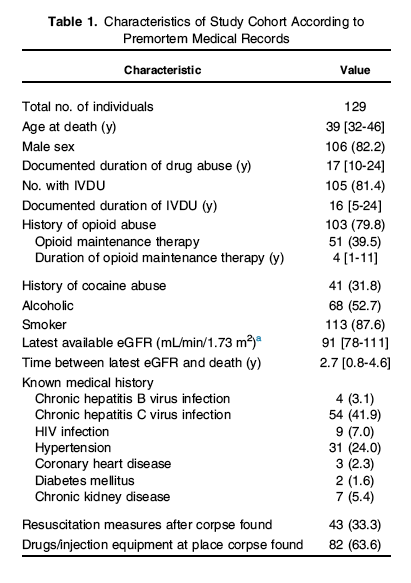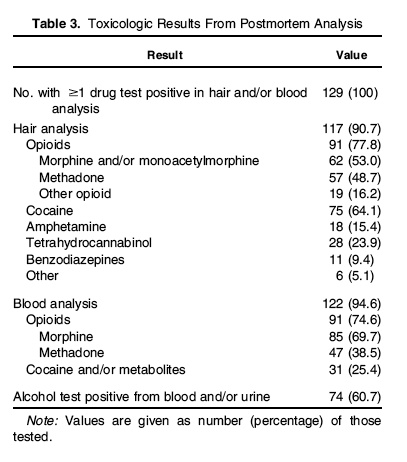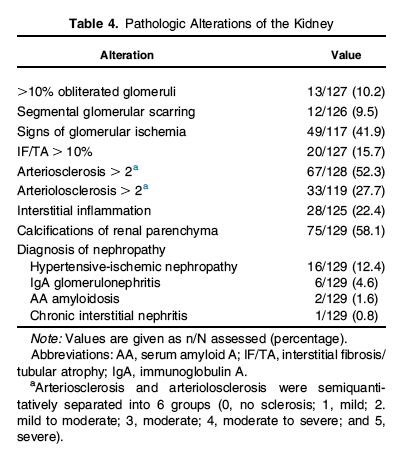| |
Nephropathy in Illicit Drug Abusers: A Postmortem Analysis...."Illicit drug abuse is an independent risk factor for chronic kidney disease"
|
| |
| |
Download the PDF here
"Illicit drug abuse is an independent risk factor for chronic kidney disease.....Illicit drug abuse is associated with a broad but unspecific spectrum of pathologic alterations of the kidneys. Cocaine abuse has a deleterious role in this setting by promoting hypertensive and ischemic damage."
American Jnl of Kidney Diseases June 2014
In summary, we found that illicit drug abuse was associated with a broad and unspecific spectrum of pathologic alterations, such as glomerular obliteration, interstitial inflammation, calcifications, and interstitial fibrosis and tubular atrophy. We could not establish a link between one uniform glomerular disease and parameters of drug abuse or concomitant chronic infectious diseases. It therefore appears likely that repeated insults to the kidney caused by multiple pharmacologic challenges due to adulterants, diluents, and/or specific drugs themselves and possibly also antigenic challenges in the setting of repeated nonsterile IVDU induce chronic progressive kidney failure. In addition, our data demonstrate the deleterious role of cocaine abuse in inducing hypertensive and ischemic damage and thus promoting the progression of kidney disease.



Discussion
The pathogenic potential of long-term exposure to illicit drugs and their accompanying contaminants under unsterile conditions remains incompletely understood. In this postmortem study in an unselected cohort of illicit drug abusers, we found a high burden of kidney pathologic states, although only a few individuals had known CKD. This is analogous to the high frequency of other comorbid conditions, especially cardiovascular diseases, not diagnosed premortem in the individuals of our cohort, emphasizing the notion that many addicts seek medical advice only when acutely ill.24 The spectrum of kidney alterations was wide, with arteriosclerotic and ischemic damage, interstitial inflammation, calcifications, and interstitial fibrosis and tubular atrophy being the most frequent, however unspecific, findings. Hypertensive-ischemic kidney disease, associated with cocaine abuse, was the predominant form of CKD, affecting >10% of the deceased. Other specific diagnoses, namely, IgA glomerulonephritis, AA amyloidosis, and chronic interstitial nephritis, were found in individual cases only.
In a series of diagnostic kidney biopsies, a 1.7% frequency of amyloidosis has been reported and reactive AA amyloidosis made up 40.3% of cases.25 Because biopsy indication is based on renal symptoms, thus causing preselection, a 1.6% frequency of AA amyloidoses in our unselected cohort is unexpectedly high. Our finding is in accordance with reports of high rates of renal AA amyloidosis in persons with IVDU.5, 16, 18, 19 On the contrary, IgA nephropathy, that is, mesangial IgA deposits, was found in 4.6% of cases, which is consistent with a consecutive autopsy study in which 4.8% of kidneys showed mesangial IgA deposits,26 indicating that drug abuse does not promote this disease.
The predominance of renal chronic vascular changes is in line with a consecutive autopsy study.27 However, our cohort in comparison was nearly 40 years younger and vascular changes should increase with age.28 Given a prevalence of hypertension of 21%-33% in men at corresponding age in established market economies,28 a frequency of 12.4% hypertensive nephropathies and 52.3% individuals with at least moderate arteriosclerosis as found in our study appears unexpectedly high. We found cocaine abuse to be a strong independent risk factor for ischemic and hypertensive renal damage. Similar findings were reported in a biopsy study of HIV-infected persons with IVDU.15 Because cocaine is a potent vasoconstrictor known to cause cardiovascular disease, a relationship between cocaine use and kidney failure is plausible.1, 29
Mechanisms underlying cocaine-related renal damage were suggested to involve hemodynamic changes, alterations in glomerular matrix synthesis, degradation, and oxidative stress, leading to ischemic nephropathy, secondary hypertension, and induction of renal atherogenesis.1, 2, 3, 15, 29, 30, 31, 32, 33, 34 However, hypertensive renal damage has been described in cocaine abusers even in the absence of systemic hypertension.2, 15 It has been suggested that there is a vicious circle of cocaine use and accelerated progression to kidney failure by hypertension, which is exacerbated and possibly triggered by sustained cocaine-induced vasoconstriction.15, 35
We could not detect glomerular damage indicating specific heroin- and HCV-related disease, for example, FSGS or MPGN, or signs of analgesic nephropathy, which is at least in part in contrast to previous studies in persons with IVDU.9, 12, 13, 16, 20 How could this be explained?
Both intravenous heroin abuse and chronic hepatitis have been associated with kidney disease, but their relative contribution is not well described. The predominant renal lesion reported in heroin users of African descent is FSGS, and in whites, it is MPGN.1 However, reports of heroin-associated nephropathy predated the surveillance of HCV and HIV, infections frequently found in persons with IVDU, and thus renal changes might originate from concomitant viral effects.1, 10 Because FSGS in heroin users and nonusers cannot be distinguished on morphologic grounds, it also has been speculated that other conditions, for example, ethnic, socioeconomic, or behavioral factors, may be of pathogenetic relevance rather than heroin's pharmacologic properties.1, 8, 36 Subsequent studies found only nonspecific renal findings and no uniform pattern of renal injury in heroin abusers.9, 15, 20, 37 We found no case of FSGS, but this entity has been described almost exclusively in African descendants,1, 8, 11 a group that is not represented in our cohort.
Similarly, contemporary studies found MPGN to be related to chronic HCV infection rather than an independent association with IVDU.5, 7, 9, 12, 13, 14, 16Although HCV infection was frequent in our cohort, in contrast to kidney biopsy studies, we found no case of HBV- or HCV-associated MPGN.5, 12, 13, 14However, in these studies, kidney biopsy was performed for nephrotic syndrome in most cases, whereas our cohort was not preselected for renal symptoms. An autopsy study of patients with chronic HCV infection found MPGN in <3% of patients, all of African American descent,38 indicating that even in the context of HCV infection, MPGN develops infrequently, in accordance with our observations, and may be dependent on ethnicity. In contrast, McGuire et al39 reported immune complex glomerulonephritis in >80% of HCV patients with liver cirrhosis, often without clinically evident kidney disease. As in our study, immunohistochemistry other than IgA staining was performed in only morphologically suspect cases and, because autolytic changes were common, very early cases of immune complex glomerulonephritis, for example, membranous glomerulonephritis, might have been missed. However, immune complex glomerulonephritis in the earlier report39 showed an interesting peculiarity, with >95% being IgA positive. Therefore, it appears improbable that a substantial number of such cases were overlooked in our analysis because we found only 6 cases with IgA deposits in a pattern typical of IgA nephropathy. Moreover, these cases were not associated significantly with the presence of HCV infection (data not shown). Although anti-HCV antibodies were observed more frequently in individuals with pathologic kidney alterations, these differences diminished after adjustment for age and parameters of drug abuse. It therefore appears possible that the presence of HCV infection is a surrogate for severity of abuse rather than an independent risk factor per se.
Comparing for the presence of metabolic lesions of the kidney, one autopsy study found nephrocalcinosis ("mainly of minor degree") in 5.5% of cases.27 In our much younger cohort, calcifications of renal parenchyma were found in 58.1%. This might indicate an imbalance in electrolyte metabolism in drug abusers. This idea could be supported by reports of cocaine and heroin abusers exhibiting soft-tissue and thymus calcifications, especially in the course of rhabdomyolysis.40, 41, 42 One therefore could hypothesize that even without rhabdomyolysis, such mechanisms might take place on a much smaller scale in drug addicts, promoting the development of renal calcifications. Because nonsteroidal anti-inflammatory drugs are used as adulterants in intravenous drugs, one could hypothesize that this might make intravenous drug abusers prone to interstitial nephritis or analgesic nephropathy. However, only one individual had interstitial inflammation sufficient to postulate interstitial nephritis.
Moreover, no case of analgesic nephropathy was detected, which is in line with the idea that phenacetin, but not its metabolite paracetamol, causes analgesic nephropathies.27
One limitation of our study is the lack of a control group. However, individuals with a comparably young age at the time of death mostly die in the setting of incurable diseases or severe trauma, when a complete autopsy usually is not performed; thus, adequate controls are lacking. Second, this is a single-center study and results may not be transferrable to other populations because drug abuse behaviors and quality or type of drugs may differ. Moreover, our white cohort may not be representative of other ethnicities, which might explain in part the lack of certain renal pathologic states reported in other studies.
Third, there is no binary concept of being a drug addict to one specific type of drug alone because consumption of several drugs in parallel is the rule, not the exception.3, 6 Even by applying toxicologic analyses, type and severity of drug abuse can be established for only the time range of the last 2 months and does not fully reflect the severity of abuse through all past years of addiction, but the development of renal pathology in this setting appears to be a dose- and time-dependent effect.6, 7
In summary, we found that illicit drug abuse was associated with a broad and unspecific spectrum of pathologic alterations, such as glomerular obliteration, interstitial inflammation, calcifications, and interstitial fibrosis and tubular atrophy. We could not establish a link between one uniform glomerular disease and parameters of drug abuse or concomitant chronic infectious diseases. It therefore appears likely that repeated insults to the kidney caused by multiple pharmacologic challenges due to adulterants, diluents, and/or specific drugs themselves and possibly also antigenic challenges in the setting of repeated nonsterile IVDU induce chronic progressive kidney failure. In addition, our data demonstrate the deleterious role of cocaine abuse in inducing hypertensive and ischemic damage and thus promoting the progression of kidney disease.
---------------------------
ABSTRACT
Background
Illicit drug abuse is an independent risk factor for chronic kidney disease, but the pathogenic consequences of long-term exposure to illicit drugs and contaminants under unsterile conditions remains unclear.
Study Design
Case series.
Setting & Participants
All deceased persons (n = 129) who underwent forensic autopsy because of suspected connection with illicit drug abuse between January 1, 2009, and April 30, 2011, in Frankfurt/Main, Germany.
Predictor
Clinical characteristics and patterns of drug abuse.
Outcomes
Histopathologic alterations of the kidney.
Measurements
Hematoxylin and eosin, periodic acid-Schiff, Sirius, and Congo Red stainings and immunoglobulin A immunohistochemistry of all cases; additional histochemical stainings or immunohistochemistry and electron microscopy in selected cases.
Results
Individuals were mostly white (99.2%), were male (82.2%), and had intravenous drug use (IVDU) (81.4%). Median age at death was 39 years and duration of drug abuse was 17 years. The majority (79.1%) took various drugs in parallel as assessed by toxicologic analysis. Despite a young age, the deceased had a high burden of comorbid conditions, especially cardiovascular disease, liver cirrhosis, and infections. Evaluation of the kidneys demonstrated a broad spectrum of pathologic alterations predominated by arteriosclerotic and ischemic damage, mild interstitial inflammation, calcification of renal parenchyma, and interstitial fibrosis and tubular atrophy, with hypertensive-ischemic nephropathy as the most common cause of nephropathy. Interstitial inflammation (OR, 16.59; 95% CI, 3.91-70.39) and renal calcification (OR, 2.43; 95% CI, 1.03-5.75) were associated with severe IVDU, whereas hypertensive and ischemic damage were associated with cocaine abuse (OR, 6.00; 95% CI, 1.27-28.44). Neither specific glomerular damage indicative for heroin- and hepatitis C virus-related disease nor signs of analgesic nephropathy were found.
Limitations
White population, lack of a comparable control group, incomplete clinical data, and absence of routine immunohistochemistry and electron microscopy.
Conclusions
Illicit drug abuse is associated with a broad but unspecific spectrum of pathologic alterations of the kidneys. Cocaine abuse has a deleterious role in this setting by promoting hypertensive and ischemic damage.
|
|
| |
| |
|
|
|